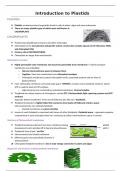Chloroplasts Study guides, Class notes & Summaries
Looking for the best study guides, study notes and summaries about Chloroplasts? On this page you'll find 2462 study documents about Chloroplasts.
All 2.462 results
Sort by
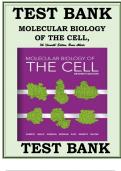
-
TEST BANK MOLECULAR BIOLOGY OF THE CELL, 7TH EDITION BRUCE ALBERTS Molecular Biology Of The Cell, 7th Seventh Edition, Bruce Alberts Current Edition Test Bank
- Exam (elaborations) • 722 pages • 2023
-
Available in package deal
-
- $59.98
- 6x sold
- + learn more
TEST BANK MOLECULAR BIOLOGY OF THE CELL, 7TH EDITION BRUCE ALBERTS Molecular Biology Of The Cell, 7th Seventh Edition, Bruce Alberts Current Edition Test Bank Contents: Chapter 01: Cells, Genomes, and the Diversity of Life Chapter 02: Cell Chemistry and Bioenergetics Chapter 03: Proteins Chapter 04: DNA, Chromosomes, and Genomes Chapter 05: DNA Replication, Repair, and Recombination Chapter 06: How Cells Read the Genome: From DNA to Protein Chapter 07: Control of Gene Expression Cha...
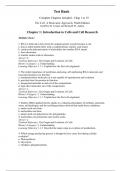 Popular
Popular
-
Test Bank for The Cell: A Molecular Approach, 9th Edition by Geoffrey Cooper
- Exam (elaborations) • 361 pages • 2023 Popular
-
- $89.49
- 4x sold
- + learn more
Test Bank for The Cell: A Molecular Approach 9e 9th Edition by Geoffrey Cooper, Kenneth Adams. Full Chapters test bank are included - Chapter 1 to 19 PART I: FUNDAMENTALS AND FOUNDATIONS Chapter 1 Introduction to Cells and Cell Research Chapter 2 Physical Principles Underlying Cell Structure and Function Chapter 3 Fundamentals of Molecular Biology PART II: THE FLOW OF GENETIC INFORMATION Chapter 4 Genes and Genomes Chapter 5 Replication, Maintenance, and Rearrangements of Ge...
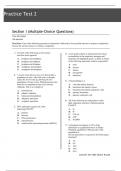
-
AP BIOLOGY EXAM PRACTICE
- Exam (elaborations) • 29 pages • 2023
-
- $9.99
- 1x sold
- + learn more
Section I (Multiple-Choice Questions) Time: 80 minutes 100 questions Directions: Each of the following questions or statements is followed by five possible answers or sentence completions. Choose the one best answer or sentence completion. 1. In which of the following are the nuclear activities most opposite? A. prophase and metaphase B. prophase and anaphase C. prophase and telophase D. metaphase and anaphase E. metaphase and telophase 2. A severe storm forms a new river that...
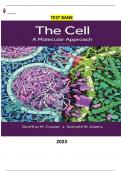
-
The Cell-A Molecular Approach 9th Edition by Geoffrey Cooper & Kenneth Adams - Complete, Elaborated and Latest Test Bank. ALL Chapters (1-19) Included and Updated for 2023
- Exam (elaborations) • 594 pages • 2023
-
- $32.88
- 1x sold
- + learn more
The Cell-A Molecular Approach 9th Edition by Geoffrey Cooper & Kenneth Adams - Complete, Elaborated and Latest Test Bank. ALL Chapters (1-19) Included and Updated for 2023 #CellMolecularApproach #CellResearch #MolecularBiologyFundamentals #GenesAndGenomes #GenomicDNAReplication #RNASynthesis #TranscriptionalRegulation #ProteinSynthesis #GenomicsAndProteomics #NuclearStructures #EndoplasmicReticulum #MitochondriaChloroplasts #Cytoskeleton #PlasmaMembrane #CellSignaling #Geoffrey...
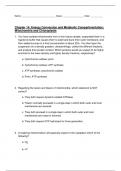
-
Chapter 14: Energy Conversion and Metabolic Compartmentation: Mitochondria and Chloroplasts TEST BANK MOLECULAR BIOLOGY OF THE CELL, 7TH EDITION BRUCE ALBERTS
- Exam (elaborations) • 27 pages • 2023
-
Available in package deal
-
- $26.98
- + learn more
Chapter 14: Energy Conversion and Metabolic Compartmentation: Mitochondria and Chloroplasts TEST BANK MOLECULAR BIOLOGY OF THE CELL, 7TH EDITION BRUCE ALBERTS
Lecture notes with additional notes from textbooks
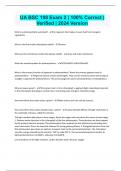
-
UA BSC 108 Exam 2 | 100% Correct | Verified | 2024 Version
- Exam (elaborations) • 7 pages • 2024
- Available in package deal
-
- $7.99
- 1x sold
- + learn more
What is a photosynthetic autotroph? - An organism that makes its own food from inorganic ingredients. What is the fluid inside chloroplasts called? - Stroma What are the membranes inside chloroplasts called? - inner and outer membranes Write the overall equation for photosynthesis. - 6CO2+6H2O→C6H12O6+6O2 What is the primary function of pigments in photosynthesis? Name the primary pigment used in photosynthesis. - Pigments absorb certain wavelengths. They are the means by which the energ...
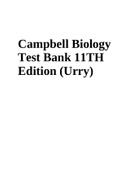
-
Campbell Biology Test Bank 11TH Edition (Urry)
- Exam (elaborations) • 1243 pages • 2023
-
- $29.49
- 6x sold
- + learn more
Campbell Biology Test Bank 11TH Edition (Urry) Cells are ________. A) only found in pairs, because single cells cannot exist independently B) limited in size to 200 and 500 micrometers in diameter C) characteristic of eukaryotic but not prokaryotic organisms D) characteristic of prokaryotic and eukaryotic organisms Answer: D Bloom's Taxonomy: Knowledge/Comprehension Section: 1.1 2) In comparison to eukaryotes, prokaryotes ________. A) are more structurally complex B) are larger C) ar...
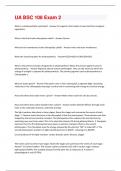
-
UA BSC 108 Exam 2 Questions And Answers Rated A+ New Update Assured Satisfaction
- Exam (elaborations) • 7 pages • 2024
- Available in package deal
-
- $8.49
- 1x sold
- + learn more
What is a photosynthetic autotroph? - Answer-An organism that makes its own food from inorganic ingredients. What is the fluid inside chloroplasts called? - Answer-Stroma What are the membranes inside chloroplasts called? - Answer-inner and outer membranes Write the overall equation for photosynthesis. - Answer-6CO2+6H2O→C6H12O6+6O2 What is the primary function of pigments in photosynthesis? Name the primary pigment used in photosynthesis. - Answer-Pigments absorb certain wavelengths. Th...
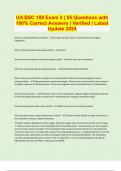
-
UA BSC 108 Exam 2 | 55 Questions with 100% Correct Answers | Verified | Latest Update 2024
- Exam (elaborations) • 7 pages • 2023
-
- $10.49
- 1x sold
- + learn more
What is a photosynthetic autotroph? - An organism that makes its own food from inorganic ingredients. What is the fluid inside chloroplasts called? - Stroma What are the membranes inside chloroplasts called? - inner and outer membranes Write the overall equation for photosynthesis. - 6CO2+6H2O→C6H12O6+6O2 What is the primary function of pigments in photosynthesis? Name the primary pigment used in photosynthesis. - Pigments absorb certain wavelengths. They are the means by which the energ...
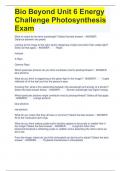
-
Bio Beyond Unit 6 Energy Challenge Photosynthesis Exam
- Exam (elaborations) • 8 pages • 2024
-
Available in package deal
-
- $8.99
- 3x sold
- + learn more
Bio Beyond Unit 6 Energy Challenge Photosynthesis Exam What is meant by the term wavelength? Select the best answer: - ANSWER Distance between two peaks Looking at the image to the right, which categories of light exist other than visible light? Select all that apply: - ANSWER Radio Infrared X-Rays Gamma Rays Which particular photons do you think contribute most to photosynthesis? - ANSWER blue photons What do you think is happening to the green light in the image? - ANSWER It gets...

-
Portage Learning: Microbiology Final Exam Set Already Passed
- Exam (elaborations) • 40 pages • 2022
- Available in package deal
-
- $10.49
- 18x sold
- + learn more
Portage Learning: Microbiology Final Exam Set Already Passed Microbiology is the study of what? Microbiology is the study of microbes (microorganisms and viruses) and their biological processes. What is the smallest biological unit of life? A cell What is a macromolecule? A macromolecule is classified as a complex molecule that is composed from smaller subunits. What are the four main types of macromolecules? Proteins, nucleic acids, lipids and carbohydrates What various functions do protein...

Do you wonder why so many students wear nice clothes, have money to spare and enjoy tons of free time? Well, they sell on Stuvia! Imagine your study notes being downloaded a dozen times for $15 each. Every. Single. Day. Discover all about earning on Stuvia



